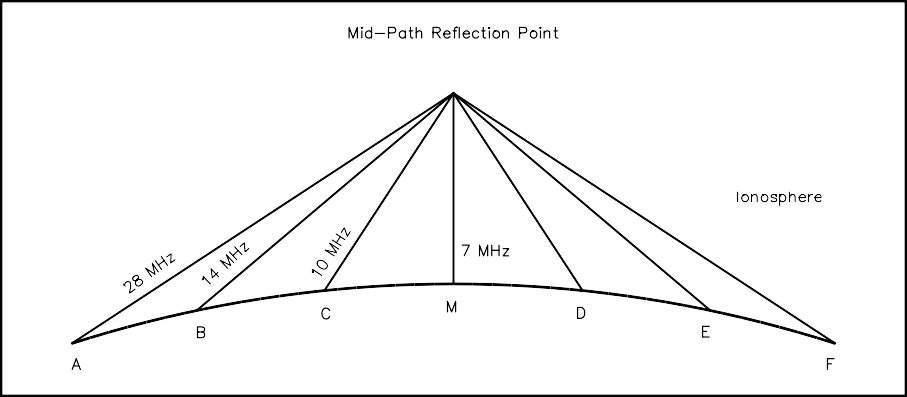Maximum and Lowest Usable Frequencies
When the frequency of a vertically incident signal is raised above the critical frequency of an iono- spheric layer, that portion of the ionosphere is unable to refract the signal back to Earth. However, a signal above the critical frequency may be returned to Earth if it enters the layer at an oblique angle, rather than at vertical inci-
 dence.
This is fortunate be- cause it permits two widely separated stations to
communi- cate on significantly higher fre- quencies than the critical
fre- quency. See Fig 21.9.
dence.
This is fortunate be- cause it permits two widely separated stations to
communi- cate on significantly higher fre- quencies than the critical
fre- quency. See Fig 21.9.
The highest frequency sup- ported by the ionosphere be- tween two stations is the maxi- mum usable frequency (MUF) for that path. If the separation
between the stations is in- creased, a still higher fre- quency can be supported at lower launch angles. The MUF for this longer path is higher than the MUF for the shorter path. When the distance is in- creased to the maximum one- hop distance, the launch angle of the signals between the two stations is zero (that is, the ray path is tangential to the Earth at
Fig 21.9—The relationships between critical frequency, maximum usable frequency (MUF) and skip zone can be visualized in this simplified, hypothetical case. The critical frequency is 7 MHz, allowing frequencies below this to be used for short-distance ionospheric communication by stations in the vicinity of point M. These stations cannot communicate by the ionosphere at 14 MHz. Stations at points B and E (and beyond) can communicate because signals at this frequency are refracted back to Earth because they encounter the ionosphere at an oblique angle of incidence. At greater distances, higher frequencies can be used because the MUF is higher at the larger angles of incidence (low launch angles). In this figure, the MUF for the path between points A and F, with a small launch angle, is shown to be 28 MHz. Each pair of stations can communicate at frequencies at or below the MUF of the path between them, but not below the LUF—see text.
the two stations) and the MUF for this path is the highest that can be supported by that layer of the ionosphere at that location. This maximum distance is about 4000 km (2500 mi) for the F2 layer and about 2300 km (1400 mi) for the E layer.
The MUF is a function of path, time of day, season, location, solar UV and X-ray radiation levels and ionospheric disturbances. For vertically incident waves, the MUF is the same as the critical frequency. For path lengths at the limit of one-hop propagation, the MUF can be several times the critical frequency. See Table 21.2. The ratio between the MUF and the critical frequency is known as the maximum usable frequency factor (MUFF).
The term skip zone is closely related to MUF. When two stations are unable to communicate with each other on a particular frequency because the ionosphere is unable to refract the signal from one to the other through the required angle — that is, the frequency is below the MUF — the stations are said to be in the skip zone for that frequency. Stations within the skip zone may be able to work each other at a lower frequency, or by ground wave if they are close enough. There is no skip zone at frequencies below the critical frequency.
The MUF at any time on a particular path is just that — the maximum usable frequency. Frequencies below the MUF will also propagate along the path, but ionospheric absorption and noise at the receiving location (perhaps due to thunderstorms, local or distant) may make the received signal-to-noise ratio too low to be usable. In this case, the frequency is said to be below the lowest usable frequency (LUF). This occurs most frequently below 10 MHz, where atmospheric and man-made noises are most troublesome. The LUF can be lowered some-
what by the use of high power
and directive antennas, or through the use of communica- tions modes that permit re- duced receiver bandwidth or are less demanding of SNR — CW instead of SSB, for ex- ample. This is not true of the MUF, which is limited by the physics of ionospheric refrac- tion, no matter how high your transmitter power or how nar- row your receiver bandwidth. The LUF can be higher than the MUF, in which case there is no frequency that supports com- munication on the particular path at that time.
